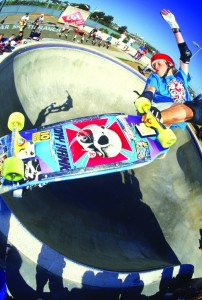ENCINITAS — If it wasn’t for surfing, decades of some of the best skateboarding and skateboarders in the North County and around the world might never have been documented.
A picture of a then-unknown skateboarder named Tony Hawk doing the first of many unimaginable maneuvers might never have been exposed to a frame of film.
If J. Grant Brittain had never moved from Fallbrook, where he grew up, to Del Mar for the surf, he most likely would be growing avocadoes, he said, instead of having become one of the most preeminent skateboard photographers in the world.
As a testament to that, Brittain, in 2014, was inducted into the Skateboarding Hall of Fame and Museum in Simi Valley, Calif.
“Brittain’s influence (especially during the ’80s) is so large that the history of skateboarding itself could not be told without including at least a dozen of his most famous action shots and portraits alike,” the Hall of Fame said of him.

But documenting the rise of skateboarding and some of its most famous skaters wasn’t at all at the root of his seeming surreptitious picking up of a camera.
“A lot of that documentation back then, it’s documentation now,” he said. “Back then we were just having fun, and the span of time has made this stuff vintage.
“I never knew that shooting a photo of Tony Hawk in 1983 would be important now. You just never thought of that. Tony was a kid going to San Dieguito and Torrey Pines, and he wasn’t making a living. It’s become really important — skate photography has — where we ended up documenting something that we didn’t know we had to document.”
Brittain grew up skating and surfing through the ‘60s and ‘70s.
Later, in 1978, living next door to professional skater Tom Inouye, Brittain caught word of a new skate park opening up in Del Mar, which would become the Del Mar Skate Ranch — where the likes of Hawk, Christian Hasoi, Ed Economy and other skaters would push their craft to new levels.
About a year into working at the skate park, Brittain borrowed a roommate’s camera and shot a roll of Kodachrome film.
“I didn’t know what I was doing,” he said. “I just knew that you needed the sun behind you and just match the exposure needle.”
From that first roll, he got one good image, but it was enough. Brittain would buy a used camera and start shooting as much as he could when he had the time.
But it was while attending Palomar College as an art major, that a friend showed him the school’s darkroom. It was there, when he saw one of his images develop in front of him, that he knew it was what he wanted to do.
Switching his major to photography, by the time he had left the college there were no other photo classes for him to take.
Forwarding some several years, Brittain was a major part of developing TransWorld Skateboarding Magazine.
For 20 years Brittain was one of the reasons for the magazine’s success.
But when Time, Inc., a division of Time Warner, Inc. purchased TransWorld Media in 2000 he began to see the corporate attitudes taking over as reason enough to leave.
He and a small group of other TransWorld employees splintered off, with the intent of starting their own, independent magazine.
The result, 10 years ago, was The Skateboard Mag.
While the recession hit them hard, last October The Skateboard Mag found a new financial backer in The Berrics — a skateboard media company founded by two professional skateboarders Steve Berra and Eric Koston.
Brittain remains at the helm of The Skateboard Mag, which is based in Carlsbad, as production manager and photo editor.
Though he may not be shooting as many skate photos as he used to, the art of the shoot is still there.
For Brittain, there can be any little thing — a certain slant of light, the color of a skateboarder’s T-shirt, the trick itself, he explained, that can really make a great skate photo.
As a skateboard photographer his role has been one of the babysitter, or the psychologist, trying to coax a skater to do something.
“Like any athlete, skaters come up against these mental blocks and they can’t do things,” he said. “So lots of times you have to talk them into it, or you’re taking them to the hospital. You just never know what capacity you are (in) when you’re out traveling around skating,” he said.
His home’s garage remains full of negatives and slides of 30-something years of skate photography — enough to fill a book with — something he said he’s been trying to work on for the past 10 years, adding that he’s glad, he didn’t throw any of those old negatives away when he was younger.
Looking at old photos and noticing that they’re not perfect, that’s what’s great about it, he explained.
“Maybe the image got messed up in the development or there are light leaks coming in from the side. It’s called the integrity of the negative and I see those things are where…I look at things more like that now and appreciate it.
“I look to the past a lot,” he said, especially looking at the masters of photography who came before him.
“You borrow styles from other photographers that have come before you,” he said. “And then I’ve just adapted those styles into my own style. And I still have my own eye and the way I look at things,” he said.
“You have to find a style, otherwise you’re just walking around with a camera,” Brittain said.
Skateboarding has taken him around the world.
“I owe everything to skateboarding and photography,” he said.



